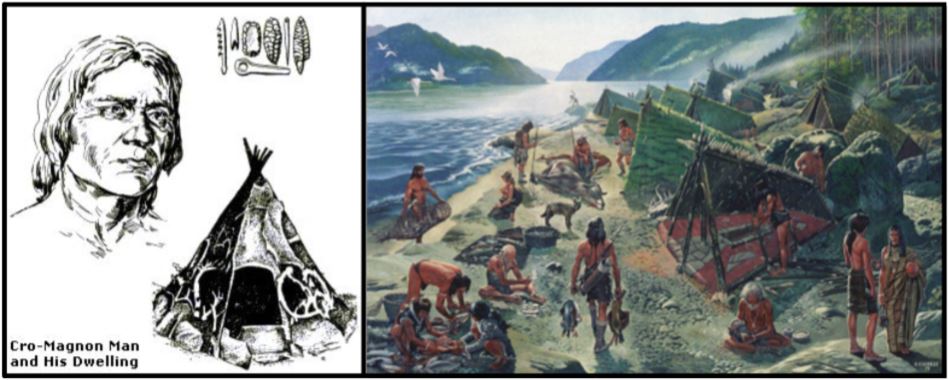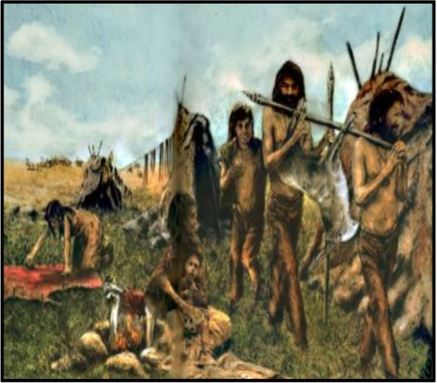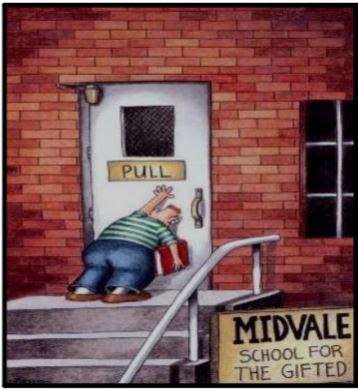Early Humans Homo Sapien

Early-Modern Humans,
40,000 BCE to 10,000 BCE
Cro-magnon is the name of the cave in France where the remains of these early humans were first discovered. Although you continue to hear these early ancestors referred to as "cro-magnons," scientists now call them early-moderns. So will we. By the time of early-moderns, humans had become very capable hunter-gatherers and had scattered all over the world. Scientists have found remains of these early people in Europe, Asia, America, Africa - all over, really. Life was harsh, but they had plenty of food and warm shelter. Many members of these groups lived to a very old age.
40,000 BCE to 10,000 BCE
Cro-magnon is the name of the cave in France where the remains of these early humans were first discovered. Although you continue to hear these early ancestors referred to as "cro-magnons," scientists now call them early-moderns. So will we. By the time of early-moderns, humans had become very capable hunter-gatherers and had scattered all over the world. Scientists have found remains of these early people in Europe, Asia, America, Africa - all over, really. Life was harsh, but they had plenty of food and warm shelter. Many members of these groups lived to a very old age.
 Although early-moderns were still hunter-gatherers, their advanced hunting skills and dwellings allowed them to create "semi-permanent" communities where they remained in place for longer periods of time. Above are examples of an early-modern winter home on the left and a summer home on the right.
Although early-moderns were still hunter-gatherers, their advanced hunting skills and dwellings allowed them to create "semi-permanent" communities where they remained in place for longer periods of time. Above are examples of an early-modern winter home on the left and a summer home on the right.
Brain Box: What social changes occurred due to advances in Early-Modern home construction?
HOMES: To shelter themselves from the long, harsh winter of the Ice Age, these early humans built semi-permanent homes. Winter homes were Ice Age huts, built tepee-style from branches and mammoth bones, covered with animal skins. These huts were used for many years, so they built them carefully. Holes were dug deeply into the ground. Poles were inserted into these holes, and then tied tightly together at the pointed top of the tepee with string made from animal guts. Warm furs were laid over this structure and sewn tightly in place. Large rocks were piled around the bottom, to help hold the hut together during long seasons of bad weather.
Some huts were built to hold only a small group of people. In the Ukraine, remains of “long huts” have been found, huts large enough to hold an entire tribe. Long huts had several entrances with multiple rooms. Many of these rooms were built around a central hearth, a place to build and keep a fire.
In the summer, following the animals, the tribe moved. They lived in sturdy tents that could be moved from place to place. As winter approached, they returned to their winter shelters. Quite often, they had to chase out the wild life that had moved in during their absence!
HOMES: To shelter themselves from the long, harsh winter of the Ice Age, these early humans built semi-permanent homes. Winter homes were Ice Age huts, built tepee-style from branches and mammoth bones, covered with animal skins. These huts were used for many years, so they built them carefully. Holes were dug deeply into the ground. Poles were inserted into these holes, and then tied tightly together at the pointed top of the tepee with string made from animal guts. Warm furs were laid over this structure and sewn tightly in place. Large rocks were piled around the bottom, to help hold the hut together during long seasons of bad weather.
Some huts were built to hold only a small group of people. In the Ukraine, remains of “long huts” have been found, huts large enough to hold an entire tribe. Long huts had several entrances with multiple rooms. Many of these rooms were built around a central hearth, a place to build and keep a fire.
In the summer, following the animals, the tribe moved. They lived in sturdy tents that could be moved from place to place. As winter approached, they returned to their winter shelters. Quite often, they had to chase out the wild life that had moved in during their absence!

FOOD: These hunter-gatherers ate a variety of seeds, berries, roots and nuts, as did their ancestors. They also ate fish and seemed to have an ample supply of freshly caught game. Hunting was done individually and in groups. They used traps, which allowed them to catch food while they were busy doing something else. Fisherman used bows and arrows, nets woven from vines, fishhooks, and even poisons. Some groups built rafts and canoes, to catch bigger fish in deeper waters.
Because they had learned to cooperate and hunt in groups, and because they were such good hunters, their lives were not a constant struggle for survival. In addition to organizing their hunts, they also learned to cure and preserve the meat they caught. That allowed them to store food for the long winter.
What are five examples of art created by early-moderns?
Because they had learned to cooperate and hunt in groups, and because they were such good hunters, their lives were not a constant struggle for survival. In addition to organizing their hunts, they also learned to cure and preserve the meat they caught. That allowed them to store food for the long winter.
What are five examples of art created by early-moderns?

CLOTHING: Early-modern's skills were both advanced and practical. Leaving nothing to waste, they used every part of the animal to make shelters, clothing, and even jewelry. In colder climates, early-moderns learned to soften leather in order to make warm, comfortable clothes. Clothing was sewn together with string made from animal guts, using needles made from bone. In warmer climates, they made cooler clothes from woven grass, and even from bark.
ART: They made necklaces and bracelets out of shells, teeth, feathers, flowers, and bone. Some people during this time decorated their bodies with paint and tattoos made from natural dyes. These may have been signs of social standing or tribal identification. In addition to jewelry, these early-moderns created pottery to store food and transport water. They learned to fire their pottery to give it luster, strength, and durability. They also created little statues, carved from ivory and bone.
What advantages did their tools give the early-modern?
ART: They made necklaces and bracelets out of shells, teeth, feathers, flowers, and bone. Some people during this time decorated their bodies with paint and tattoos made from natural dyes. These may have been signs of social standing or tribal identification. In addition to jewelry, these early-moderns created pottery to store food and transport water. They learned to fire their pottery to give it luster, strength, and durability. They also created little statues, carved from ivory and bone.
What advantages did their tools give the early-modern?

TOOLS & WEAPONS: Humans had learned to be skilled toolmakers. It was during this time that they created a new weapon, the bow and arrow. Weapons included stone axes, knives, spears, harpoons, and the new wooden bows and sharp stone-tipped arrows. Both the saber-toothed tiger and the woolly mammoth became extinct during this period but, most probably, that reflects a shift in climate rather than hunting by humans.
CAVE PAINTINGS: Today, marvelous cave paintings are one of the things that we most closely identify with the early-moderns. For whatever reason, these ancestors of ours created wonderful paintings on rock walls deep within caves. Many different individuals added paintings to the same cave until a cave might have hundreds of paintings, all of them painted on rock walls deep in the darkest region of the cave.
Most cave paintings focused on hunters and animals. Early moderns used natural colors. Most art was made with mineral pigments, such as iron oxide (red ochre) or black manganese. They drew stick figures for people, but the animals were well drawn, and usually filled in with natural colors, to give them even more shape and substance.
CAVE PAINTINGS: Today, marvelous cave paintings are one of the things that we most closely identify with the early-moderns. For whatever reason, these ancestors of ours created wonderful paintings on rock walls deep within caves. Many different individuals added paintings to the same cave until a cave might have hundreds of paintings, all of them painted on rock walls deep in the darkest region of the cave.
Most cave paintings focused on hunters and animals. Early moderns used natural colors. Most art was made with mineral pigments, such as iron oxide (red ochre) or black manganese. They drew stick figures for people, but the animals were well drawn, and usually filled in with natural colors, to give them even more shape and substance.

When you think cave, you might think of a big place, with high ceilings. Not so. In order to reach the places where cave paintings have been found, early-moderns had to crawl on their belly, through mazes of narrow, dark tunnels, by the light of a flickering torch or a spoon-like oil lamp. To do this, while crawling along on your belly, the lamp had to be hand carried and balanced carefully to hold the burning oil in the rounded part of the spoon.
Early-moderns also had to carry the paints they had carefully prepared. It was very dangerous. This early man had no idea if he might run into a cave lion or a bear on the way. Certainly, since these marvelous paintings were hidden deep within the darkest portions of the cave, this early human was not decorating his home.
Brain Box: What can we conclude about early-modern society by looking at their art?
Early-moderns also had to carry the paints they had carefully prepared. It was very dangerous. This early man had no idea if he might run into a cave lion or a bear on the way. Certainly, since these marvelous paintings were hidden deep within the darkest portions of the cave, this early human was not decorating his home.
Brain Box: What can we conclude about early-modern society by looking at their art?

Besides stick figures of people and well-drawn animals, the other thing found in cave paintings, are stencils of hands. Stencils like those pictured at right are found on rock walls on every continent that people have lived.It would appear that early-moderns, after crawling on their belly and adding their creation to these walls of cave art, they put their hand against the cave wall, and outlined it with charcoal or paint. What were they saying? (I was here? I made this?) Was this a way to sign their art? Or to prove they had achieved their mission? Since not all paintings include a stenciled hand print, it’s not easy to figure out.
.
Why did early-moderns seek out these caves to add their paintings to the many others that had been painted in the cave before them? And why such dark, secret, hidden places? It might have been one of early-modern’s recreational activities. It might have had something to do with their religion or their rites of adulthood. Nobody knows! It’s a fascinating mystery.
Activity: Use this lessons reading to complete the last row of your Early Humans Comparison Chart. Then, check your answers with those provided by clicking the "Check Your Chart" button below.
.
Why did early-moderns seek out these caves to add their paintings to the many others that had been painted in the cave before them? And why such dark, secret, hidden places? It might have been one of early-modern’s recreational activities. It might have had something to do with their religion or their rites of adulthood. Nobody knows! It’s a fascinating mystery.
Activity: Use this lessons reading to complete the last row of your Early Humans Comparison Chart. Then, check your answers with those provided by clicking the "Check Your Chart" button below.

